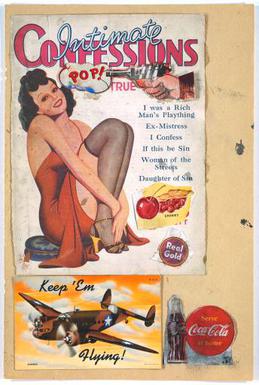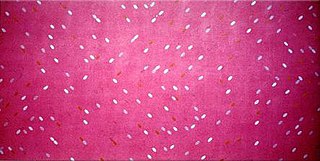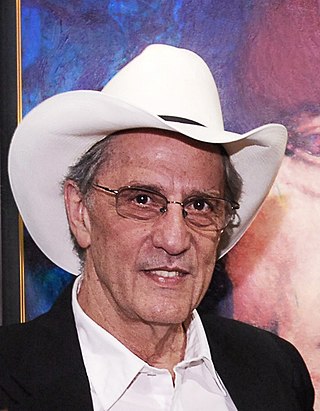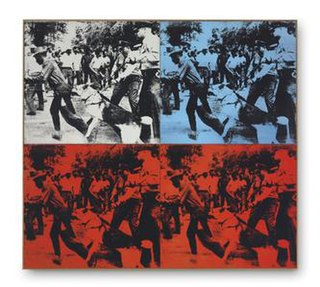
Andy Warhol was an American visual artist, film director and producer. A leading figure in the pop art movement, Warhol is considered one of the most important American artists of the second half of the 20th century. His works explore the relationship between artistic expression, advertising, and celebrity culture that flourished by the 1960s, and span a variety of media, including painting, silkscreening, photography, film, and sculpture. Some of his best-known works include the silkscreen paintings Campbell's Soup Cans (1962) and Marilyn Diptych (1962), the experimental films Empire (1964) and Chelsea Girls (1966), and the multimedia events known as the Exploding Plastic Inevitable (1966–67).

Pop art is an art movement that emerged in the United Kingdom and the United States during the mid- to late-1950s. The movement presented a challenge to traditions of fine art by including imagery from popular and mass culture, such as advertising, comic books and mundane mass-produced objects. One of its aims is to use images of popular culture in art, emphasizing the banal or kitschy elements of any culture, most often through the use of irony. It is also associated with the artists' use of mechanical means of reproduction or rendering techniques. In pop art, material is sometimes visually removed from its known context, isolated, or combined with unrelated material.
Abstract expressionism in the United States emerged as a distinct art movement in the immediate aftermath of World War II and gained mainstream acceptance in the 1950s, a shift from the American social realism of the 1930s influenced by the Great Depression and Mexican muralists. The term was first applied to American art in 1946 by the art critic Robert Coates. Key figures in the New York School, which was the center of this movement, included such artists as Arshile Gorky, Jackson Pollock, Franz Kline, Mark Rothko, Norman Lewis, Willem de Kooning, Adolph Gottlieb, Clyfford Still, Robert Motherwell and Theodoros Stamos among others.

Milton Ernest "Robert" Rauschenberg was an American painter and graphic artist whose early works anticipated the Pop art movement. Rauschenberg is well known for his Combines (1954–1964), a group of artworks which incorporated everyday objects as art materials and which blurred the distinctions between painting and sculpture. Rauschenberg was primarily a painter and a sculptor, but he also worked with photography, printmaking, papermaking and performance.
Point of Order! is a 1963 American documentary film by Emile de Antonio about the Senate Army–McCarthy hearings of 1954.

Elaine Frances Sturtevant, also known professionally as Sturtevant, was an American artist. She achieved recognition for her carefully inexact repetitions of other artists' works.
Painters Painting: The New York Art Scene 1940-1970 is a 1972 documentary directed by Emile de Antonio. It covers American art movements from abstract expressionism to pop art through conversations with artists in their studios. Artists appearing in the film include Willem de Kooning, Jasper Johns, Andy Warhol, Robert Rauschenberg, Helen Frankenthaler, Frank Stella, Barnett Newman, Hans Hofmann, Jules Olitski, Philip Pavia, Larry Poons, Robert Motherwell, and Kenneth Noland.
Events from the year 1964 in art.
Underground is a 1976 documentary film about the Weathermen, founded as a militant faction of the Students for a Democratic Society (SDS), who fought to overthrow the U.S. government during the 1960s and 1970s. The film consists of interviews with members of the group after they went underground and footage of the anti-war and civil rights protests of the time. It was directed by Emile de Antonio, Haskell Wexler, and Mary Lampson, later subpoenaed by the Federal Bureau of Investigation in an attempt to confiscate the film footage in order to gain information that would help them arrest the Weathermen.
Henry Geldzahler was a Belgian-born American curator of contemporary art in the late 20th century, as well as a historian and critic of modern art. He is best known for his work at the Metropolitan Museum of Art and as New York City Commissioner of Cultural Affairs, and for his social role in the art world with a close relationship with contemporary artists.

In the Year of the Pig is an American documentary film directed by Emile de Antonio about American involvement in the Vietnam War. It was released in 1968 while the U.S. was in the middle of its military engagement, and was politically controversial. One year later, the film was nominated for the Academy Award for Best Documentary Feature. In 1990, Jonathan Rosenbaum characterized the film as "the first and best of the major documentaries about Vietnam".
Millhouse: A White Comedy is a 1971 documentary by Emile de Antonio following Richard Nixon's political career from his election to the House of Representatives in 1946 to his election as President of the United States in 1968. It begins with Nixon's "last press conference" in 1962 after his loss in the race for Governor of California in which he famously said, "You won't have Dick Nixon to kick around anymore." Then a collage of videos show Nixon's trajectory from his House campaign to his involvement in the Alger Hiss case, election to the Senate in 1950, election as Vice President in 1952 including the full Checkers speech, campaign for the presidency in 1960, campaign for Barry Goldwater's presidential candidacy in 1964, and his triumphant election as President in 1968 as the "New Nixon". The film featured interviews but no voice-over.
Athan George Theoharis was an American historian, professor of history at Marquette University in Milwaukee, Wisconsin. As well as his extensive teaching career, he was noteworthy as an expert on the Federal Bureau of Investigation (FBI), J. Edgar Hoover, and U.S. intelligence agencies, having written and edited many books on these and related subjects.

Marie Menken was an American experimental filmmaker, painter, and socialite. She was noted for her unique filming style that incorporated collage. She was one of the first New York filmmakers to use a hand-held camera and trained Andy Warhol on its use. Her film Glimpse of the Garden was selected for preservation in the National Film Registry by the Library of Congress.
Deborah Kass is an American artist whose work explores the intersection of pop culture, art history, and the construction of self. Deborah Kass works in mixed media, and is most recognized for her paintings, prints, photography, sculptures and neon lighting installations. Kass's early work mimics and reworks signature styles of iconic male artists of the 20th century including Frank Stella, Andy Warhol, Jackson Pollock, and Ed Ruscha. Kass's technique of appropriation is a critical commentary on the intersection of social power relations, identity politics, and the historically dominant position of male artists in the art world.

Lawrence M. "Larry" Poons is an American abstract painter. Poons was born in Tokyo, Japan, and studied from 1955 to 1957 at the New England Conservatory of Music, with the intent of becoming a professional musician. After seeing Barnett Newman's exhibition at French and Company in 1959, he gave up musical composition and enrolled at the School of the Museum of Fine Arts, Boston. He also studied at the Art Students League of New York. Poons taught at The Art Students League from 1966 to 1970 and currently teaches at the League.

James Francis Gill is an American artist and one of the protagonists of the Pop art movement.

20th-century Western painting begins with the heritage of late-19th-century painters Vincent van Gogh, Paul Cézanne, Paul Gauguin, Georges Seurat, Henri de Toulouse-Lautrec, and others who were essential for the development of modern art. At the beginning of the 20th century, Henri Matisse and several other young artists including the pre-cubist Georges Braque, André Derain, Raoul Dufy and Maurice de Vlaminck, revolutionized the Paris art world with "wild", multi-colored, expressive landscapes and figure paintings that the critics called Fauvism. Matisse's second version of The Dance signified a key point in his career and in the development of modern painting. It reflected Matisse's incipient fascination with primitive art: the intense warm color of the figures against the cool blue-green background and the rhythmical succession of the dancing nudes convey the feelings of emotional liberation and hedonism.

Race Riot is a 1964 acrylic and silkscreen painting by the American artist Andy Warhol that he executed in 1964. It fetched $62,885,000 at Christie's in New York on 13 May 2014.










